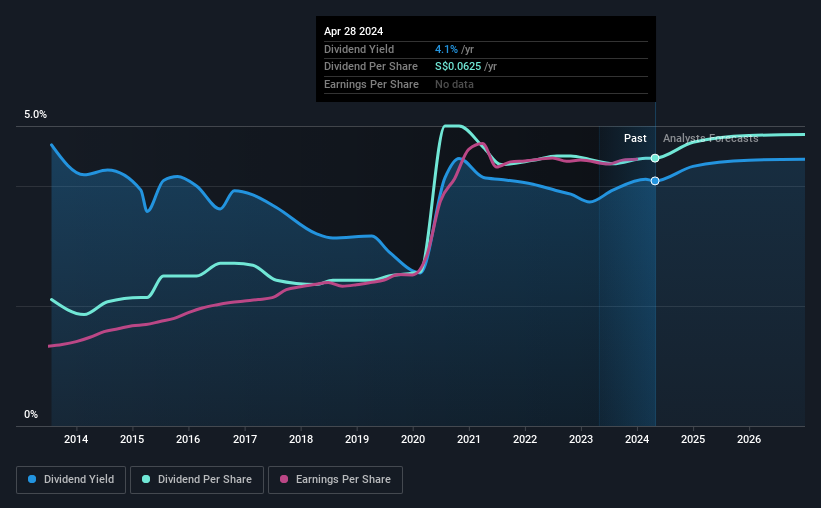Sheng Siong Group Ltd (SGX:OV8) Looks Like A Good Stock, And It's Going Ex-Dividend Soon
It looks like Sheng Siong Group Ltd (SGX:OV8) is about to go ex-dividend in the next 3 days. The ex-dividend date occurs one day before the record date which is the day on which shareholders need to be on the company's books in order to receive a dividend. It is important to be aware of the ex-dividend date because any trade on the stock needs to have been settled on or before the record date. This means that investors who purchase Sheng Siong Group's shares on or after the 3rd of May will not receive the dividend, which will be paid on the 17th of May.
The company's next dividend payment will be S$0.032 per share, on the back of last year when the company paid a total of S$0.062 to shareholders. Calculating the last year's worth of payments shows that Sheng Siong Group has a trailing yield of 4.1% on the current share price of S$1.53. Dividends are an important source of income to many shareholders, but the health of the business is crucial to maintaining those dividends. As a result, readers should always check whether Sheng Siong Group has been able to grow its dividends, or if the dividend might be cut.
View our latest analysis for Sheng Siong Group
Dividends are typically paid out of company income, so if a company pays out more than it earned, its dividend is usually at a higher risk of being cut. Sheng Siong Group paid out 70% of its earnings to investors last year, a normal payout level for most businesses. A useful secondary check can be to evaluate whether Sheng Siong Group generated enough free cash flow to afford its dividend. It distributed 49% of its free cash flow as dividends, a comfortable payout level for most companies.
It's positive to see that Sheng Siong Group's dividend is covered by both profits and cash flow, since this is generally a sign that the dividend is sustainable, and a lower payout ratio usually suggests a greater margin of safety before the dividend gets cut.
Click here to see the company's payout ratio, plus analyst estimates of its future dividends.
Have Earnings And Dividends Been Growing?
Businesses with strong growth prospects usually make the best dividend payers, because it's easier to grow dividends when earnings per share are improving. If earnings fall far enough, the company could be forced to cut its dividend. Fortunately for readers, Sheng Siong Group's earnings per share have been growing at 14% a year for the past five years. Sheng Siong Group has an average payout ratio which suggests a balance between growing earnings and rewarding shareholders. This is a reasonable combination that could hint at some further dividend increases in the future.
Many investors will assess a company's dividend performance by evaluating how much the dividend payments have changed over time. In the last 10 years, Sheng Siong Group has lifted its dividend by approximately 7.8% a year on average. It's encouraging to see the company lifting dividends while earnings are growing, suggesting at least some corporate interest in rewarding shareholders.
Final Takeaway
Has Sheng Siong Group got what it takes to maintain its dividend payments? We like Sheng Siong Group's growing earnings per share and the fact that - while its payout ratio is around average - it paid out a lower percentage of its cash flow. There's a lot to like about Sheng Siong Group, and we would prioritise taking a closer look at it.
While it's tempting to invest in Sheng Siong Group for the dividends alone, you should always be mindful of the risks involved. For example - Sheng Siong Group has 1 warning sign we think you should be aware of.
If you're in the market for strong dividend payers, we recommend checking our selection of top dividend stocks.
Have feedback on this article? Concerned about the content? Get in touch with us directly. Alternatively, email editorial-team (at) simplywallst.com.
This article by Simply Wall St is general in nature. We provide commentary based on historical data and analyst forecasts only using an unbiased methodology and our articles are not intended to be financial advice. It does not constitute a recommendation to buy or sell any stock, and does not take account of your objectives, or your financial situation. We aim to bring you long-term focused analysis driven by fundamental data. Note that our analysis may not factor in the latest price-sensitive company announcements or qualitative material. Simply Wall St has no position in any stocks mentioned.

